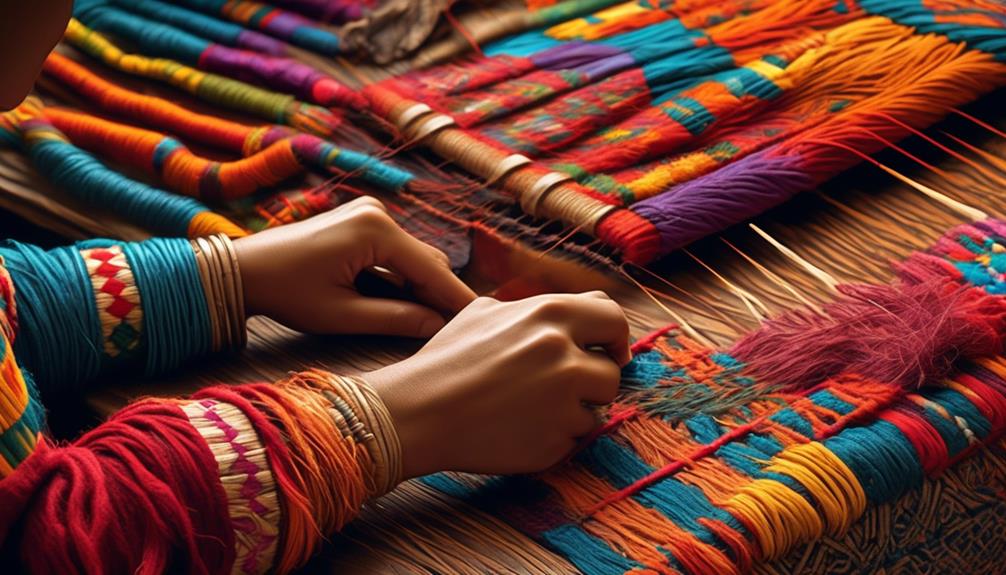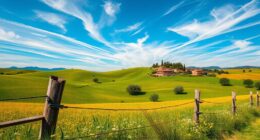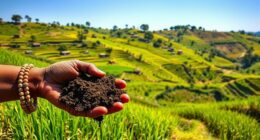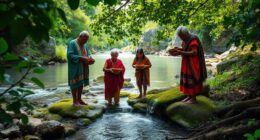Before the Dutch arrived, it should be remembered that Manhattan was not vacant. It is often overlooked that the island was inhabited by various thriving Native American communities for centuries.
But who were these Indigenous peoples, and what was their relationship to the land? Exploring the complex history of Manhattan's early inhabitants reveals a rich tapestry of cultures, traditions, and land stewardship practices that continue to shape the city's identity today.
Key Takeaways
- Early indigenous inhabitants of Manhattan had a strong presence, with archaeological evidence of settlements and skilled hunting and cultivation practices.
- Land ownership and stewardship were based on communal ownership systems, with collective responsibility and sustainable land management techniques.
- Cultural practices and traditions, including ceremonial rituals, storytelling, and skilled craftsmanship, were significant in preserving indigenous heritage.
- European colonization had a devastating impact on indigenous communities, leading to displacement, cultural assimilation, and environmental degradation.
Early Indigenous Inhabitants of Manhattan
Little is known about the early indigenous inhabitants of Manhattan prior to European contact, but archaeological evidence suggests a rich and complex history. Early settlements in Manhattan were likely strategically located near bodies of water, such as the East and Hudson Rivers, providing access to valuable resources. The indigenous peoples of Manhattan were skilled hunters, relying on a variety of hunting practices to sustain their communities.
Archaeological findings reveal evidence of tools and weapons used for hunting, as well as remains of animals that were hunted for food and other resources. These early inhabitants also cultivated the land, growing crops such as maize, beans, and squash, contributing to the development of a more settled way of life.
The presence of these early settlements and the sophisticated hunting practices of the indigenous peoples demonstrate a deep understanding of the natural environment and a complex social organization. These findings provide invaluable insights into the lives of the early indigenous inhabitants of Manhattan, shedding light on their resourcefulness, adaptability, and cultural practices.
Land Ownership and Stewardship
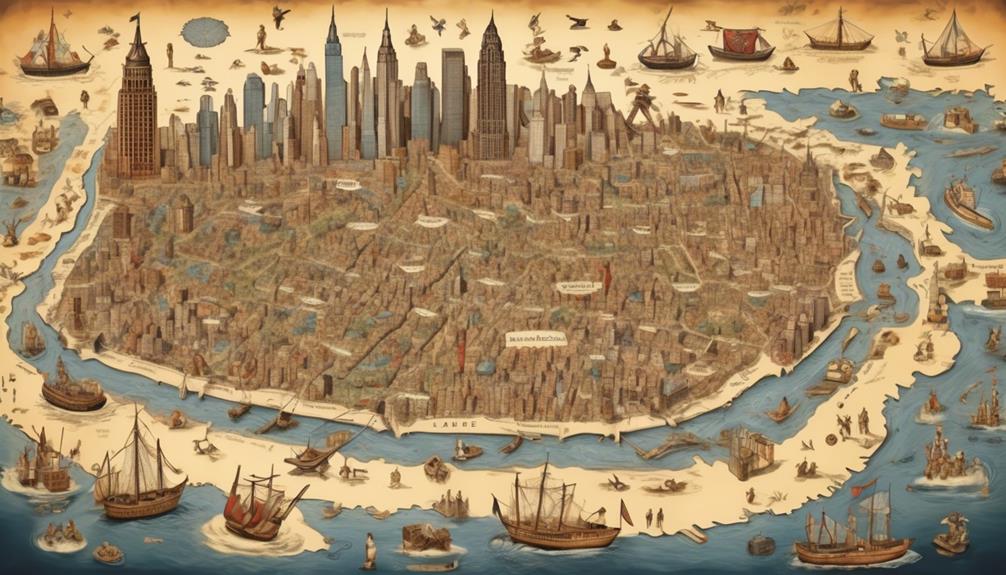
The historical records and archaeological evidence provide insight into the indigenous peoples of Manhattan's land ownership and stewardship practices.
- Intergenerational Custodianship: Indigenous ownership of land in Manhattan wasn't characterized by individual ownership in the European sense. Rather, it was a communal ownership system where different tribes held collective responsibility for the stewardship of specific areas. This intergenerational custodianship was deeply rooted in spiritual and cultural beliefs, guiding sustainable land use and preservation practices.
- *Sustainable Land Management:* The indigenous peoples practiced sustainable land management techniques such as controlled burns for agricultural purposes, selective harvesting of resources, and the establishment of seasonal settlements to allow ecosystems to regenerate. These practices were integral to maintaining the ecological balance and biodiversity of the land.
- *Spiritual Connection to the Land:* Land stewardship was intertwined with spiritual beliefs, emphasizing the interconnectedness between humans and nature. This spiritual connection guided their conservation efforts, ensuring that the land and its resources were preserved for future generations.
The indigenous peoples of Manhattan implemented land stewardship practices that emphasized communal ownership, sustainability, and spiritual reverence for the land, contributing to the preservation of the island's natural resources for centuries.
Cultural Practices and Traditions
Cultural practices and traditions among the indigenous peoples of Manhattan reflect a rich tapestry of social customs, artistic expressions, and ceremonial rituals that were integral to their identity and way of life. These practices and traditions were deeply rooted in their spiritual beliefs and played a significant role in shaping their communities. The table below provides a glimpse into some of the key cultural practices and traditions of the indigenous peoples of Manhattan.
| Cultural Practices | Description | Importance |
|---|---|---|
| Ceremonial Rituals | Sacred ceremonies marking important events such as harvest, solstices, and rites of passage. | Strengthened community bonds and honored their connection to the land. |
| Storytelling Traditions | Oral traditions passed down through generations, preserving history, legends, and spiritual beliefs. | Preserved cultural heritage and provided moral and spiritual guidance. |
| Traditional Arts and Crafts | Skilled craftsmanship in creating pottery, beadwork, and intricate textiles. | Expressed cultural identity and conveyed symbolic meanings. |
| Spiritual Beliefs and Practices | Animistic beliefs centered around nature, spirits, and the interconnectedness of all living beings. | Guided ethical behavior and reinforced their relationship with the natural world. |
The indigenous peoples of Manhattan maintained these cultural practices and traditions as a way of connecting with their past, understanding the present, and ensuring the continuity of their heritage.
Impact of European Colonization
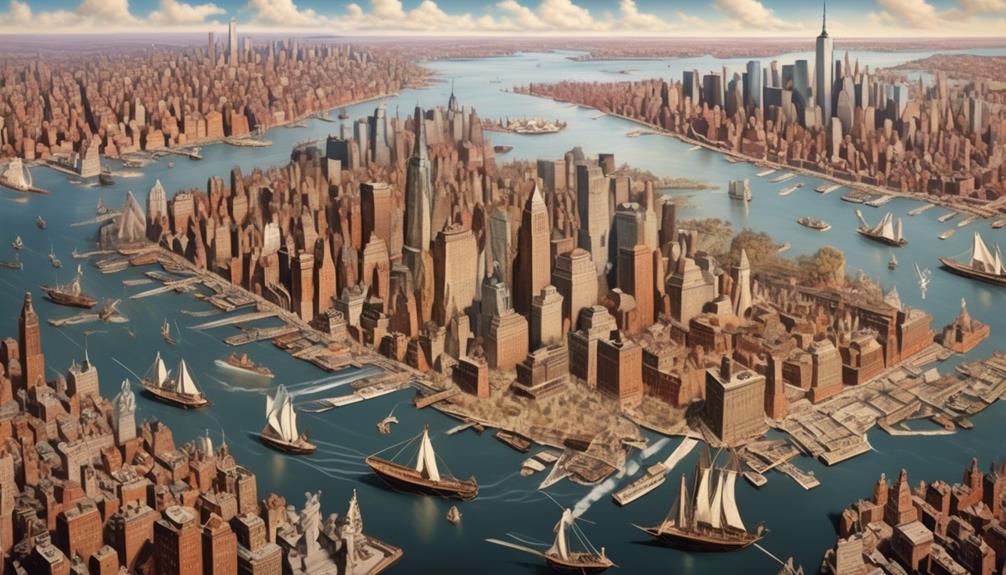
Upon the arrival of European colonizers, the indigenous peoples of Manhattan were profoundly impacted by the radical shifts in social, economic, and political dynamics within their ancestral lands. This period of European colonization brought about significant changes, and its effects are still felt today.
The impact of European colonization on the indigenous peoples of Manhattan can be summarized as follows:
- Economic Displacement and Cultural Assimilation
European colonization led to the displacement of indigenous communities from their traditional economic activities, such as hunting, fishing, and agriculture. The imposition of European economic systems disrupted the indigenous peoples' traditional way of life, leading to economic hardships and loss of autonomy. Additionally, cultural assimilation efforts by the European colonizers resulted in the erosion of indigenous cultural practices and traditions, contributing to a loss of cultural identity and heritage.
- Loss of Traditional Territories and Environmental Degradation
The arrival of European colonizers resulted in the loss of indigenous peoples' traditional territories through forced relocations, broken treaties, and land seizures. This loss of land not only disrupted their way of life but also led to environmental degradation as European settlement and resource extraction practices altered the natural landscape, impacting the indigenous peoples' relationship with the environment.
Legacy and Contributions to Manhattan
Despite the profound disruptions caused by European colonization, the indigenous peoples of Manhattan have left a lasting legacy and made significant contributions to the cultural and historical fabric of the island. Their resilience and preservation of their cultural heritage in the face of adversity have deeply influenced the identity of Manhattan. The enduring traditions, art, and oral histories of the Lenape, Munsee, and other indigenous groups continue to resonate within the city.
Moreover, the ongoing efforts to recognize tribal sovereignty and promote indigenous rights have contributed to a greater understanding of the historical injustices faced by the original inhabitants of Manhattan. The push for official recognition of indigenous tribes and their land rights has gained momentum, leading to a more inclusive representation of the island's history and the acknowledgment of the enduring presence of indigenous peoples.
The legacy of the indigenous peoples of Manhattan is an essential part of the city's identity. Their contributions, both past and present, continue to shape the cultural landscape and foster a greater appreciation for the diverse heritage that enriches the island.
Frequently Asked Questions
What Were the Specific Names of the Indigenous Tribes That Inhabited Manhattan Before the Dutch Arrived?
Before the Dutch colonization, Manhattan was home to several indigenous tribes known for their rich cultural practices, land stewardship, and spiritual beliefs. These tribes included the Lenape, who were the original inhabitants of the area. They played a vital role in shaping the land and its resources.
Today, modern preservation efforts aim to honor and uphold the legacy of these indigenous peoples and their contributions to the region.
How Did the Indigenous Peoples of Manhattan View Land Ownership and Stewardship in Relation to Their Cultural and Spiritual Beliefs?
Land ownership, spiritual beliefs, and cultural stewardship were deeply intertwined in the practices of the indigenous tribes on Manhattan. Their traditional views emphasized collective responsibility and a deep connection to the land.
European colonization disrupted these practices, imposing foreign concepts of ownership. This led to profound consequences for the indigenous peoples and the land itself.
Understanding these historical dynamics sheds light on the complexities of land ownership and stewardship in indigenous cultures.
What Were Some Traditional Cultural Practices and Traditions of the Indigenous Peoples of Manhattan?
Traditional ceremonies, harvesting practices, indigenous storytelling, cultural dances, and language preservation were integral to the indigenous peoples of Manhattan. These practices reflected our deep connection to the land, our spiritual beliefs, and our community ties.
Through these traditions, we honored our ancestors, celebrated nature's abundance, and passed down our cultural heritage. Our cultural practices were essential for maintaining our identity and sustaining our way of life.
Artisanal crafts were also an important aspect of our culture. We used these crafts to create beautiful, functional objects that were both practical and symbolic. The skills and techniques passed down through generations allowed us to express our creativity and preserve our cultural heritage.
What Specific Impacts Did European Colonization Have on the Indigenous Peoples of Manhattan, Both in the Short and Long Term?
In the short term, European colonization brought devastating impacts on the indigenous peoples of Manhattan, akin to a sudden storm wreaking havoc. This included loss of land, resources, and autonomy.
In the long term, the consequences were equally severe, leading to cultural disintegration, displacement, loss of traditional knowledge, and decimation of populations.
The enduring effects of colonization continue to shape the lives and experiences of indigenous peoples today.
How Have the Contributions and Legacy of the Indigenous Peoples of Manhattan Been Preserved and Celebrated in Modern Times?
Preservation efforts for indigenous peoples' contributions and cultural celebrations in Manhattan have gained significance in modern times. The focus on preserving the legacy of these communities reflects a growing recognition of their historical and cultural importance.
Efforts to maintain and celebrate indigenous traditions have become increasingly visible, providing an opportunity for broader acknowledgment of their enduring impact on the region. These initiatives play a crucial role in honoring and perpetuating the rich heritage of Manhattan's indigenous peoples.
Conclusion
In conclusion, the Lenape people were the original Indigenous inhabitants of Manhattan, caring for and owning the land long before the arrival of the Dutch. It's estimated that around 15,000 Lenape people lived in the region before European colonization.
Their rich cultural practices and traditions continue to have a lasting impact on the history and heritage of Manhattan, reminding us of the resilience and contributions of Indigenous peoples.





